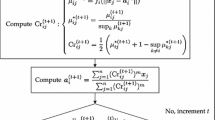Abstract
Hybrid methods of spatial credibilistic clustering and particle swarm optimization (SCCPSO) (Wen et al. in Int J Fuzzy Syst 10:174–184, 2008) are validated to be effective, and produce better results than other common methods. In this paper, SCCPSO is further investigated and a modified SCCPSO is put forward by discussing the membership functions and presenting a pre-selection method based on proving an evaluation criterion on the clustering results. The analysis of computational complexity demonstrates the feasibility of the modified SCCPSO. Experiments verify the discussion on the membership functions, the correctness of the evaluation criterion, as well as the effectiveness of the pre-selection method and the modified SCCPSO.







Similar content being viewed by others
References
Ahmed MN, Yamany SM, Mohamed N, Farag AA, Moriarty T (2002) A modified fuzzy c-means algorithm for bias field estimation and segmentation of MRI data. IEEE Trans Med Imag 21:193–199
Bezdek JC (1981) Pattern recognition with fuzzy objective function algorithms. Plenum, New York
Bratton D, Kennedy J (2007) Defining a standard for particle swarm optimization. In: Proceeding of the 2007 IEEE swarm intelligence symposium, pp 120–127
Cai W, Chen S, Zhang D (2007) Fast and robust fuzzy c-means clustering algorithms incorporating local information for image segmentation. Pattern Recogn 40:825–838
Chen SC, Zhang DQ (2004) Robust image segmentation using FCM with spatial constraints based on new kernel-induced distance measure. IEEE Trans Syst Man Cybern B 34:1907–1916
Kennedy J, Eberhart R (1995) Particle swarm optimization. In: Proceedings of the 1995 IEEE international conference on neural networks, pp 1942–1948
Lee J, Lee D (2005) An improved cluster labeling method for support vector clustering. IEEE Trans Pattern Anal Mach Intell 27:461–464
Lee J, Lee D (2006) Dynamic characterization of cluster structures for robust and inductive support vector clustering. IEEE Trans Pattern Anal Mach Intell 28:1869–1874
Liew AWC, Leung SH, Lau WH (2000) Fuzzy image clustering incorporating spatial continuity. In: Proceedings of industrial electronic engineering—vision, image, signal processing, pp 185–192
Liew AWC, Yan H, Law NF (2005) Image segmentation based on adaptive cluster prototype estimation. IEEE Trans Fuzzy Syst 13:444–453
Liu B, Wan C, Wang LP (2006) An efficient semi-unsupervised gene selection method via spectral biclustering. IEEE Trans Nano Biosci 5:110–114
Pham DL (2002) Fuzzy clustering with spatial constraints. In: IEEE Proceedings of the international conference image processing, pp II65–II68
Pham DL, Prince JL (1999) An adaptive fuzzy c-means algorithm for image segmentation in the presence of intensity inhomogeneities. Pattern Recogn Lett 20:57–68
Runkler TA, Katz C (2006) Fuzzy clustering by particle swarm optimization. In: 2006 IEEE international conference on fuzzy systems, pp 601–608
Shi Y, Eberhart R (1998) A modified particle swarm optimizer. In: IEEE World Congress on computational Intelligence, evolutionary computation proceedings, pp 69–73
Szilágyi L, Benyó Z, Szilágyii SM, Adam HS (2003) MR brain image segmentation using an enhanced fuzzy c-means algorithm. In: Proceedings of 25th annual international conference of IEEE EMBS, pp 17–21
Tseng VS, Kao CP (2005) Efficiently mining gene expression data via a novel parameterless clustering method. IEEE/ACM Trans Comput Biol Bioinf 2:355–365
Wang L, Liu Y, Zhao X, Xu Y (2006) Particle swarm optimization for fuzzy c-means clustering, In: The Sixth World Congress on intelligent control and automation, pp 6055–6058
Wen P, Zheng L, Zhou J (2007) Spatial credibilistic clustering algorithm in noise image segmentation. In: Proceedings of IEEE international conference on industrial engineering and engineering management, pp 543–547
Wen P, Zhou J, Zheng L (2008) Hybrid methods of spatial credibilistic clustering and particle swarm optimization in high noise image segmentation. Int J Fuzzy Syst 10:174–184
Yang MS, Wu KL (2006) Unsupervised possibilistic clustering. Pattern Recogn 39:5–21
Zadeh LA (1978) Fuzzy sets as a basis for a theory of possibility. Fuzzy Sets Syst 1:3–28
Zadeh LA (1979) Toward a theory of approximate reasoning. In: Hayes J, Michie D, Mikulich L (eds) Mathematical Frontiers of the social and policy sciences. Westview Press, Boulder, pp 69–129
Zhang L, Zhou C, Ma M, Liu X, Li C, Sun C, Liu M (2006) Fuzzy kernel clustering based on particle swarm optimization. In: 2006 IEEE international conference on granular computing, pp 428–430
Zhou J, Hung CC (2007) A generalized approach to possibilistic clustering algorithms. Int J Uncertain Fuzziness Knowl Based Syst 15:117–138
Zhou J, Hung CC, Wang X, Chen S (2007) Fuzzy clustering based on credibility measure. In: Proceedings of the sixth international conference on information and management sciences, pp 404–411
Acknowledgments
This work was supported by a grant from the National Natural Science Foundation of China (No. 70771058), the National High Technology Research and Development Program of China (863 Program) (No. 2008AA04Z102), and Tsinghua Basic Research Foundation (No. 52202301), as well sponsored by Caterpillar Inc., USA.
Author information
Authors and Affiliations
Corresponding author
Rights and permissions
About this article
Cite this article
Wen, P., Zhou, J. & Zheng, L. A modified hybrid method of spatial credibilistic clustering and particle swarm optimization. Soft Comput 15, 855–865 (2011). https://doi.org/10.1007/s00500-010-0553-7
Published:
Issue Date:
DOI: https://doi.org/10.1007/s00500-010-0553-7




